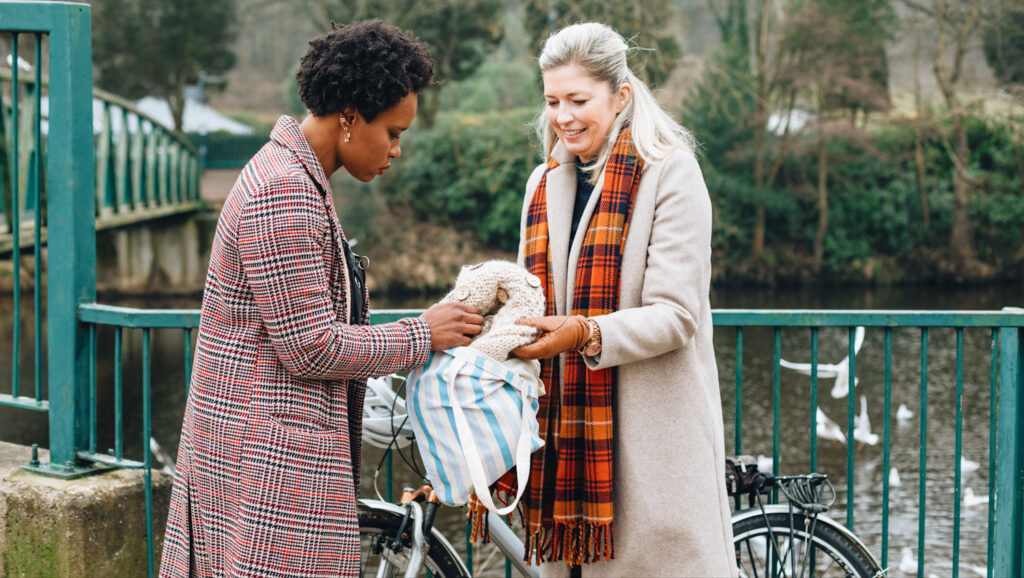It was a wintry day on Bainbridge Island and my friend Rebecca and I were collecting seashells with our kids. When our little ones presented their collected treasures, we were stunned: Instead of mussel or oyster shells, they found plastic bottle caps; instead of seaweed, plastic ribbons from balloons; and instead of aquatic animal bones, broken-up Bic pens and plastic buckles.
As we dug bare-handed in the cool sand to make sandcastles, we discovered a good percentage of the microscopic granules of sand were actually thousands of microplastics—which, according to the U.S. National Oceanic and Atmospheric Administration, are fragments of every kind of plastic that measure less than 5 millimeters in length. This was our watershed moment.

A sea of plastic
Our beaches are becoming more plastic by the day, due to the unfettered and unnecessary overproduction of plastic goods worldwide. If we don’t all participate in reducing our waste and cleaning up our environment, we’re complicit in the flow of plastics into every body of water—and every body of every animal and human—on this planet.
Plastics now outnumber the essential food supply for oceanic life, called zooplankton, by at least six to one. Broken-down microplastics look just like zooplankton and they’re ingested by nearly every organism that exists in the ocean, which means they eventually make their way into our bodies.
If we don’t all participate in reducing our waste and cleaning up our environment, we’re complicit in the flow of plastics into every body of water—and every body of every animal and human—on this planet.
This fact may shock you: Humans eat about a credit card-sized amount of plastic every week. These plastics don’t just come from dense plastic items, like your shampoo bottle; the most insidious plastic particles enter our waterways through clothing. When we wash items like fleece jackets and yoga pants, microfibers enter our waterways through grey water that goes down the drain.
The very forces that create our climate are contributing to the distribution of plastics, which means plastics are now found in the rainwater that falls in the Himalayas and the Rocky Mountains, deposited onto our glaciers which melt down to our seas. A recent study found bits of plastic outnumber baby fish by seven to one in nursery waters off Hawaii. You’ll also find those little buggers in your sea salt products and a good percentage of the pelagic fish that are caught for food, including open sea species like swordfish and mahi-mahi. We are all becoming some part plastic and studies reveal that these endocrine disruptors may pose dangers for our health, as well as our planet.

The birth of the global Buy Nothing movement
So what could Rebecca and I, as only two people, do to help foster change in the world of waste? We wondered if we could encourage our neighbors to buy less, sending a clear message to manufacturers that we don’t need more of this stuff. Could we literally “buy nothing?”
Our question spawned a social movement, called the Buy Nothing Project, inspiring neighbors to share their stuff, rather than throwing it away. Here’s how it works: people post for things they want (an Ask) while simultaneously offering something they no longer need (a Give). Neighbors see posts and respond to what they want. It’s both a zero-waste movement and a means to build community. We’ve developed a new app that removes the need to have Facebook, as well as the need for any local gatekeepers—now you can ask and gift anywhere, anytime.
Much of our material goods, of course, happen to be plastic. Over the last 8.5 years, we’ve launched over 6,800 Buy Nothing local gift economies, with 4.27 million participants in 44 nations, and we have saved millions of tons of plastics, metals, glass, wood, textiles and organics from the landfill. Perhaps equally as important, we’ve fostered community and the ability for neighbors to meet and rely upon each other as a beneficial side effect.
Our movement is growing rapidly. Two million members joined Buy Nothing between March 2020 and October 2021. People are re-gifting, loaning, or giving everything, including couches, old LPs, fresh food from their veggie gardens, outgrown clothing, and used smartphones. They’re also giving gifts of human kindness, whether it’s words of encouragement and advice during a tough time, or a ride to the train station or grocery store. When my own daughter needed strappy shoes to wear to homecoming, the community provided exactly what she needed (and she has expensive taste). When our rice cooker died, a neighbor just a short walk down the street provided one for us. And when my neighbor was expecting her grandchild for a week-long visit, we were able to deliver to her our community loan-out high chair.
But it’s not just our movement that we’re interested in perpetuating; it’s any global radical regifting movement. We’re hoping to help dispel the scarcity mindset and replace it with the mindful practice of actively sharing our abundance. We all have plenty to share, whether it’s a rarely-used toaster or our presence at a game of Scrabble with an elderly neighbor.
What we’ve seen globally and locally as a result of such radical regifting is that fewer people are going to big box stores and dollar stores to buy plastic goods that are easily disposable into our oceans and landfills. It takes a village and, as it turns out, our villages are full of the very stuff and the generous people that can bind us together, buoying us forth into a future where giving, asking, gratitude, sharing and resilience can all happen without buying one more unnecessary plastic thing.
The views expressed in opinion pieces are those of the author(s) and do not represent the policy or position of LIVEKINDLY.


